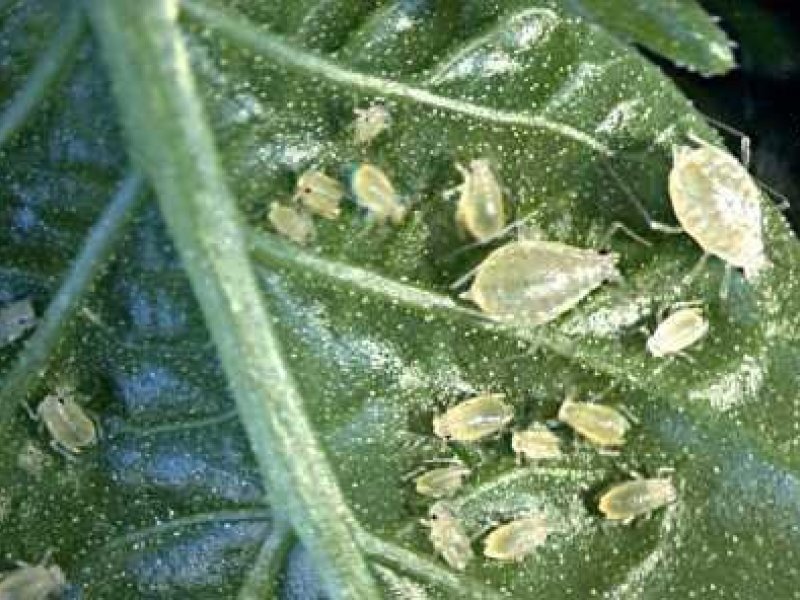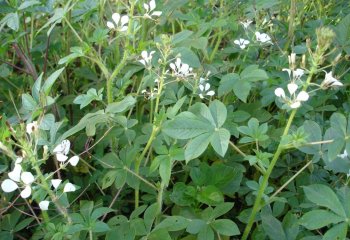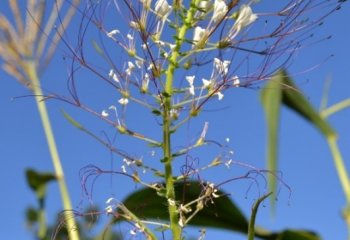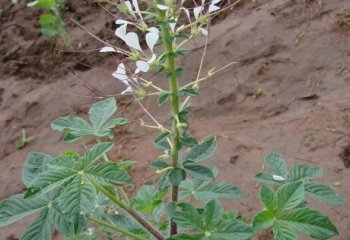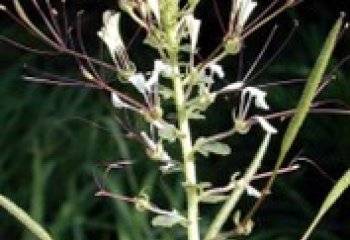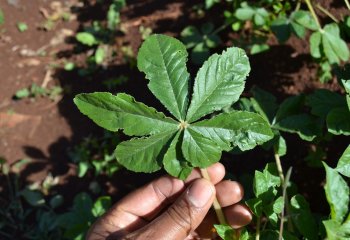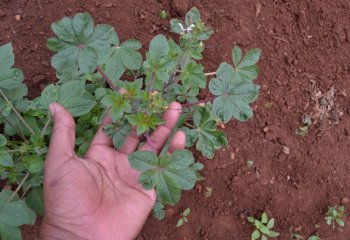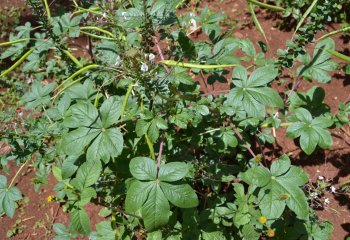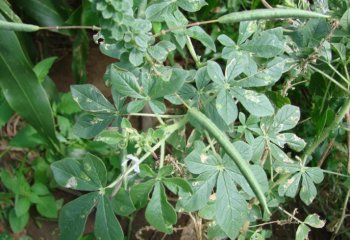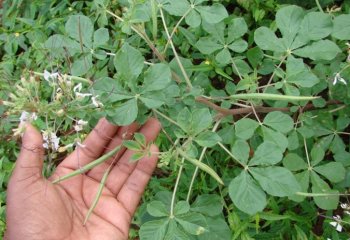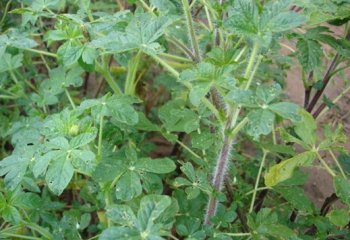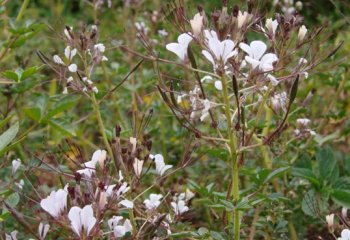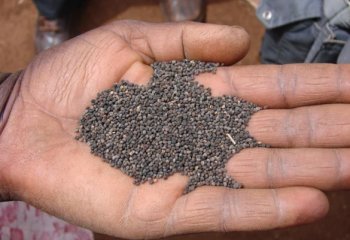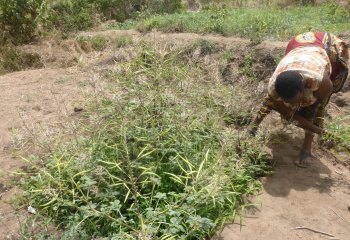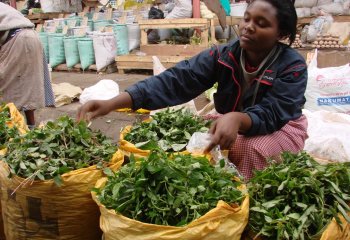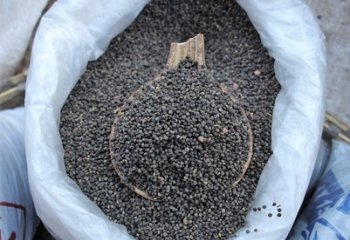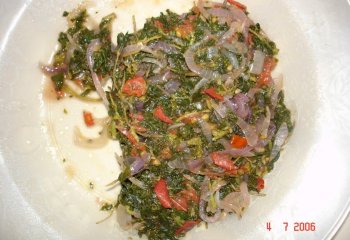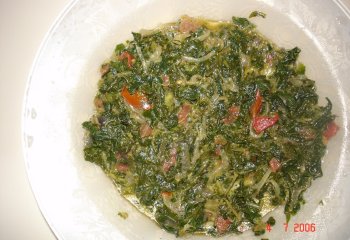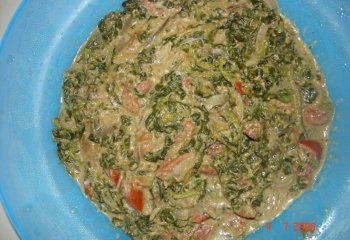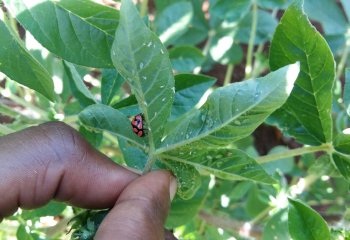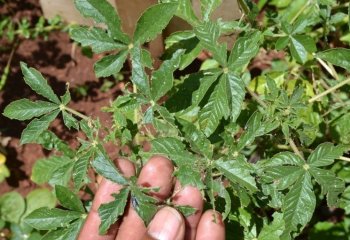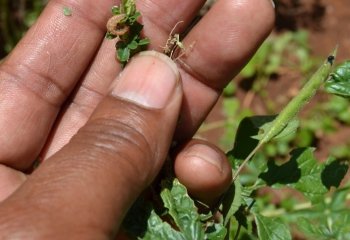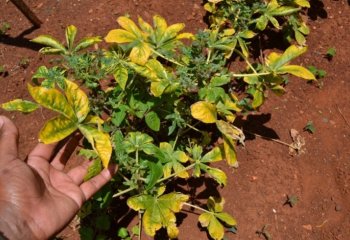|
Aphids Aphids can be serious pests during dry weather. Aphids are a major pest, causing leaves to curl and become unattractive to customers.
Aphids feed by sucking plant sap. Small aphid populations may be relatively harmless, but heavily infested plants usually have wrinkled leaves, stunted growth and deformed pods. Plants, particularly young plants, may dry out and die under heavy aphid attack. Heavy attack on older plants may cause crop loss by decreasing flower and capsule production. Damage may also reduce seed viability. |
|
|
What to do:
|
|
Beetles Pure stands in Nairobi were observed to be attacked by flea beetles (Phyllotreta mashonana). (EcoPort: Wilfried Baudoin).
Flea beetles are tiny to small with enlarged hindlegs that enable them to jump long distance when disturbed. The adults vary in colour from shiny black or metallic grey to black with yellow stripes on the wing cases. Eggs are laid in the soil near the host plant. The larvae generally feed on the plant roots, but usually do not cause economic damage. The characteristic symptom of flea beetle attack is small, round holes all over the leaf surface. Damage may be of importance when flea beetles are present in large numbers, especially during the seedling stage. |
|
|
What to do:
|
Geographical Distribution in Africa
Geographical Distribution of Spiderplant in Africa. Source GBIF https://www.gbif.org/species/3041500
Read more
DRC Congo: Suntha, Lyuniyi, Lubanga, Sishungwa, Chishugwa, Shungwa (Chweya &Mnzava., 1997); Elekondia, Elekondjo, Ganga Mikiri (Ngwaka Bowelengeze) (Ngombe); Olokonzia (Mbanza); Bofata (Ngbandi); Mushaka kanamafuji (Kinyindu) (C. rutidosperma) (Yamada, T., 1999); Musaka (Kirega) (C. rutidosperma) (Mbuta,2012).
Egypt: Abu quarn, Arareeg, Tamaleekah, Tokshangeth (Chweya J.A. & Mnzava N.A., 1997).
Ethiopia: Boekbeha, Gargama (Heuzé et al., 2020); Xaaraa (Konta) (C. gynandra); Ononu (Oromiffa) (C. gynandra) (Eshetu, G.R. et al., 2015)
Gabon: Ndume (Fang) (C. gynandra) (Walker, A., & Sillans, R., 1961).
Ghana: Bùdùnì (Dagomba) (Cleome viscosa L). (Blench, R. & Dendo, M. (2006).
Ivory Coast: Niamé (Shien); Sango (Gouro) (Bouquet, A., & Debray, M., 1974)
Kenya: Mwangani (Chonyi); Mwangani (Giriama); Mwianzo, Mukakai (Kamba, Machakos); Sake, Mwaanzo, Ithea-Utuku (Kamba, Kitui); Mwangani (Kambe); Saka (Keiyo); Thagiti, `Thageti (Kikuyu); Isakyat, Isagek, Isakiat (Kipsigis); Chinsaga (Kisii); Esaka (Singular), Chiisaka (Plural) Luhya (Bukusu); Tsisaka (Luhya (Kisa); (Kisa, Kabras, Tiriki); Lisaka Luhya (Tachoni); Chiisaka (Plural), Yisaka (Singular) Luhya (Marachi); (Samia); Dek (Luo); Akeyo, Alot-Dek, Deg-Akeyo (Homa Bay); Maa: Lemba-E-Nabo (Siaya); Olmuateni, Oljani-Lool-Tatwa ((Elang'ata Wuas); Naibor Lukunya (Meto); Sachan, Suroyo (Marakwet); Munyugunyugu Okiek: Isakiat, Isagek (Plural)(Meru); Suriyo, Suriya, Karelmet (Pokot); Bekeila-Ki-Dakhan, Sabaot: Sakiantet (Rendille); Sabai, Lasaitet (Samburu); Mwangani (Sanya); Jeu-Gurreh (Somali); Mkabili, Mwangani (Swahili); Ecadoi (Teso); Kisakiat (Tugen); Echaboi, Akio (Turkana) (C. gynandra) (Maundu et al., 1999)
Malawi: Siira, Luni (Yao) (Maundu, 2007)
Mauritius: Lerotu, Erotho (G.gynandra). (Chweya J.A. & Mnzava N.A., 1997).
Mozambique: Runi (Maundu, 2007)
Niger: Tabaday (Hausa); Hubay (Zarma) (Jazy, M.A et al., 2017).
Nigeria: Ekuya (C. gynandra) (Ainslie, J. R., 1937)
Reunion: Aija (C. gynandra), Brede caya, Pissat des chiens (C. viscosa, C. gynandra) (Chweya J.A. & Mnzava N.A, 1997).
Rwanda: Isogi (Kinyarwanda) (African Museum, 2021).
Somalia: Jeu-gurreh, Aija (C. gynandra) (Heuzé et al., 2020); Palmbossie, Vingerblaartee (Chweya J.A. & Mnzava N.A, 1997).
South Africa: Oorpeultjie (Afrikaans); Lerotho (Sepedi & Sesotho); Murudi (Tshivenda); Rirudzu, Bangala (Tsonga); Ulude (Ndebele) (African museums., 2021); Tamaleika, Akaki, Angyiri, Ziri (Chweya J.A. & Mnzava N.A., 1997); Mutohotoho (Venda) (C. monophylla).
Sudanese: Tamaleika, Akaki, Agyiri; Ziri (Sudanese) (Heuzé et al., 2020); Mgagani; Mwage-nazi (Chweya J.A. & Mnzava N.A, 1997).
Tanzania: Mzimwe (Gogo); Chensaga (Kuria); Mgange (Luguru); Moga, MMung'agn'e (Nyaturu); Mwange (Sambaa) (Maundu, 2006); Ejjoboyo, Isaga, Akeyo, Eshogi, Eyobyo, Ekiau; Ekaboi Ecaboi; Ekeyo; Tegeri; Jirri, Eshoje (Chweya J.A. & Mnzava N.A., 1997); Mugagani (Nyamwezi) (C. gynandra) (Ruffo, C.K., 1991).
Togo: Itchètchè (Akassélem); Sabo (Adja); Somboé, Samboé (Mina); Soboé (Ewé) (Adjanohoun, É., & Technique, A.D, 1986); Sombitsou (Cleome viscosa L). (Agbodeka, K et al., 2016).
Uganda: Gasaya; Nasege; Kinaski; Ngor si bidar (C. gynandra) (Chweya J.A. & Mnzava N.A., 1997); Akeyo (Alur) (C. gynandra) (Oryem, H., & Mugisha, M.K., 2014); Esobyo, Amarera (Rukonjo), Eshogi (Runyankole) (C. gynandra) (Mugisha, M. K, & Oryem-Origa, H., 2007); Kayobyo yobyo (C. gynandra)
West Africa: Boanga, Mugole, Muhole, Isogi, Lubanga, Mangayamangaya (C. gynandra) (Chweya J.A. & Mnzava N.A., 1997).
Zambia: Lubanga (Bemba); Sishungwa (Libowa); Lutembwe; Namanga; Suntha; Msunta; Luyuni; Luni; Luyoni; Chioni; Shungwa (Tonga); Chishungwa; Siungwa; Chishuungwa; Naga, (Guarino., 1997); Nyevhe, Tsinga, Ulude, Bangara, Ulede, Rumi (Chweya J.A. & Mnzava N.A., 1997).
Zaire: Suntha, Lyuniyi, Lubanga, Sishungwa, Chishugwa, Shungwa (Chweya J.A. & Mnzava N.A., 1997).
Zimbabwe: Nyeuhe, Elude (Chweya J.A. & Mnzava N.A., 1997); Nyovhi (Shona) (C. gynandra) (Maroyi, A., 2013); Musemwasemwa (Shona) (C. monophylla L) (Maroyi, A., 2013).
General Information and Agronomic Aspects
Introduction
Spider plant is an erect herbaceous annual herb with hairy, often purple stems and many branches growing to a height of about one metre. The plant has edible leaves; each leaf has up to 7 leaflets spreading like fingers, which are usually 2-10 cm long and 2-4 cm wide. The flowers are rather showy, long and bearing many small white or pink flowers. The elongate fruit resembles a pod, but is referred to as a capsule, containing many small, dark seeds. Spider plant originated in Africa and Tropical Asia but now has a worldwide distribution. The plant is either cultivated or harvested from the wild. It is a fast-growing plant that is ready for harvest in as few as three weeks. Spiderplant is a member of the genus Cleome in family Cleomaceae. The genus comprises 150–200 species, with about 50 occurring in Africa. Previously, the spiderplant was classified in the family Capparaceae, in the order Capparales. However, recent taxonomic revisions have merged Gynandropsis with Cleome as the distinctive characters, such as the connection of the staminal base with the gynophore to form an androgynophore is merely a quantitative character.
Spiderplant, once considered a weed in most African countries, is now a valuable food source and income for local communities. It does well in abandoned fields, along roadsides, and elsewhere where the soil has not been disturbed. This crop is gaining popularity in most of Africa. In Kenya, Uganda, Tanzania, Zambia and Zimbabwe, it has lately transitioned from being a tolerated weed to a cultivated crop.
Spiderplant is a highly nutritious vegetable that is widely consumed in rural areas of East and Southern Africa. The tender leaves, young shoots, and occasionally flowers are boiled and eaten as a potherb, relish, stew, or side dish. The leaves can be utilized in fresh form or dried and ground into a powder. The leaves are bitter and often cooked with milk or vegetables such as Cowpea, Amaranth, and Nightshade. In other areas, the leaves are boiled, and the cooking water is discarded. The leaves may be blanched, made into small balls, and sun- or air-dried. This popular product in southern Africa finds a ready market when available during the rainy season.
Fresh spiderplant leaves are often used as ingredients in mashed foods in East Africa, while dried leaves are incorporated into weaning foods. Some Kenyan communities refer to spiderplant as a "traditional meat" because it is believed to replenish blood. Boiled spiderplant leaves are traditionally given to new mothers and warriors after blood loss. Similarly, an infusion of the leaves is used to treat anaemia. The leaves and seeds are used medicinally as rubefacient and vesicant, treating rheumatism externally and internally. An infusion of the roots is used as a medicine for chest pain and leaves to treat diarrhoea. Spiderplant seeds thrown in water can kill fish, which float to the surface. The glands on the stems and leaves have insect-repellent properties; cabbage and related crops intercropped with spiderplant suffer less from diamondback moth larvae. (Maundu et al., 1999, Schippers, R. R, 2000; Chweya J.A. & Mnzava N.A., 1997; Mnzava, N.A. & Chigumira Ngwerume, F., 2004; GBIF Secretariat, 2021; AVRDC & IPGRI, 2006)
The leaves are eaten as a cooked green vegetable, have a mildly bitter taste and contain 5% protein, 6% carbohydrates and are high in vitamins A and C, calcium, phosphorus and iron. Spider plant is used as a vegetable, and as such adds important nutrients to the diet in rural areas of East and Southern Africa. The leaves are usually cooked when fresh but may also be dried and stored for up to two years although this practice greatly reduces the crop's nutrition value.
In East Africa, fresh leaves are used as ingredients in other mashed foods, and the dried leaves are ground and incorporated in weaning foods. Spider plant is believed to replenish blood and therefore referred to as a "traditional meat" by some Kenyan communities (Chweya and Mnzava, 1997; Savala et al, 2003).
Ⓒ P. Maundu 2008
Related species
1. Cleome gynandra is likely to have originated in tropical Africa and Southeast Asia and is widely distributed in drier areas of the tropics and Subtropics. The vegetable is found mainly near human settlements in Africa. It occurs probably in all the countries of tropical Africa.
2. Cleome hirta occurs from Ethiopia and Somalis through Eastern and Central Africa to Southern Africa and has occasionally been introduced in Western tropical Africa and Madagascar.
3. Cleome monophylla is widespread in tropical and subtropical Africa, including Madagascar and other Indian Ocean Islands, and is also found in India and Sri Lanka.
4. Cleome rutidosperma is a pantropical weed of coastal regions and is widely distributed from Senegal to Angola, particularly in the coastal areas, but often extending deeply into the interior. Occasionally it has been found as a weed in East Africa (Uganda and Tanzania). In Nigeria, it occurs as a weed in rice fields. In West Africa, it is occasionally cultivated as a potherb.
5. Cleome viscosa occurs in Northern Tropical Africa, from Cape Verde and Senegal to Egypt, Ethiopia, and Zanzibar; It is absent in Southern Africa but present in Madagascar and other Indian Ocean islands. Outside Africa, it is widespread in Peninsular Arabia, Tropical Africa, Australia, and tropical and subtropical America.
6. Cleome allamanii, locally called Mwangani muthithe (meaning small spiderplant) is found in East African coast.
7. Cleome usambarica, occurs in Sudan, Ethiopia, Kenya, and Tanzania.(Grubben, G.J.H. & Denton, O.A, 2004, Chweya J.A. & Mnzava N.A, 1997, Nana, P. & Foyet, H.S, 2013)
Species accounts
Cleome gynandra is an erect herb to 1.3 m high (usually 0.5-1.0 m). Stems hairy, rather oily. Leaves: On long stalks, usually divided into 3, 5, and 7 leaflets, to 7 cm long. Flowers: White or pink borne on a long much-branched inflorescence. Fruit: A long-stalked capsule splitting to release small rough, greyish-black seeds. It is a fast-growing plant ready for harvest in as few as three weeks. The leaves are eaten as a cooked green vegetable, have a mildly bitter taste. (Maundu et al, 1999, Savala et al., 2003, Mnzava et al., 2004)
|
Ⓒ Maundu 2010 |
© Maundu, 2010 |
Cleome hirta is a bushy annual to short-lived perennial plant with an erect, much-branched stem growing up to 1.5 m. The stem is covered with glandular hairs, which can also be found in other parts of the plant, and is sticky to the touch.
The plant can be found in various habitats, such as deciduous woodland, dry savanna grassland, and sandy plains. As a weed, the plant can be found on the roadside, in disturbed soils, and in farmland. It is used as a vegetable in Tanzania, Uganda, DRC Congo, and Zimbabwe. The leaves are taken to reduce hypertension, and the boiled roots are used to cure measles in various parts of Africa. (Grubben, G.J.H. & Denton, O.A, 2004, Fern, 2021)
Cleome monophylla (spindle pod) is an annual herb that can grow up to 1 meter in height. It is found in various habitats, including savannah grasslands, deciduous woodlands, bushlands, lakeshores, disturbed land, and cultivated areas. The plant has simple leaves and a spindle pod that lacks robust branching, distinguishing it from C. gynandra and C. hirta. It is less bitter than C. gynandra, making it a preferred choice, and can be identified by its pink petals, slightly hairy oblong leaves, and stamens not much longer than the corolla. C. monophylla, despite its unpleasant odor, is a highly versatile plant that has found numerous uses in Africa. The pounded seeds of this plant are often used as a substitute for mustard, while the young leaves and shoots are employed as a flavorful addition to various dishes. Medicinally. In Nigeria, crushed leaves are used against headaches, and finely ground leaves are used to remove irritating particles from the eyes. In Tanzania, the dried ground leaves are used for sores, and the roots are chewed to treat cough. The entire plant is used externally to treat swelling. The essential oil extracted from C. monophylla has been found to repel the tick (Riphicephalus appendiculatus) and the maize weevil (Stophilus zeamais). (Ndungu et al., 1994, Grubben, G.J.H. & Denton, O.A, 2004, Schippers, R. R, 2000)
Cleome rutidosperma is an erect annual herb growing up to 0.5 m tall and branched from the base. The stem is green with a purplish tinge and is covered in fine hairs or glandular pubescence. It is adapted to thrive in humid and hot conditions, primarily in low attitudes. Typically, it is found in areas with an annual rainfall of 1700-3000 mm and can grow up to 400m Latitude. The leaves of this plant are collected from the wild and can be cooked as a vegetable or added to soup. The leaves have a bitter taste, similar to mustard, and in Uganda, butter is added to enhance the vegetable's flavor. In Ghana, Gabon, and DRC Congo, the leaf sap is used to cure earaches and deafness. In Ghana, the leaf extract treats skin irritation, while in Nigeria, it treats convulsions. In Malaysia, the plant is used to control insects, particularly by diverting diamondback moths' oviposition from cultivated plants. (Grubben, G.J.H. & Denton, O.A, 2004).
Cleome viscosa is an annual sticky herb growing up to 1 meter tall. The plant has a robust penetrating odor when bruised and is clothed with yellowish glandular hairs; the plant occurs in woodland and grassland and is a weed of fallow land fields, roadside, and wasteland, often occurring in sandy soils. It is found under seasonal dry and humid conditions, from sea level up to 1000 m altitude. In tropical Africa, C. viscosa is occasionally used as a leafy vegetable. The bitter leaves are locally popular and eaten fresh, dried, or cooked. The picked young fruits are also eaten. The plant is used as an essential covers crop and green manure in areas where it occurs in abundance. The whole herb is rubbed on the body against rheumatism. The seeds and their oil have anthelminthic properties but are ineffective in treating roundworm infections. The roots remedy scurvy and rheumatism (Grubben, G.J.H. & Denton, O.A, 2004, Ravindra G. Mali., 2010).
Cleome usambarica occurs in Sudan, Ethiopia, Kenya, and Tanzania. A cold water infusion of the roots, together with the roots of Macaranga capensis is taken in Kenya before a meal twice a day as an aphrodisiac. (Nana, P. & Foyet, H.S., 2013). Young leaves of spiderplants are widely used as spinach in Africa. These leaves can be dried and stored for later use, usually as a relish eaten with maize meal. This food is rich in magnesium and iron, as well as nicotinic acid.
(EcoPort (http://www.ecoport.org): Roger P. Ellis)
Variation in spiderplant
Spiderplant exhibits immense variation, especially in East Africa. Various morphological characteristics such as leaflets and the pod shape, stem and petal color, the texture of the pods, and stem and leaf hairiness display significant variation.
Although the spiderplant species is found throughout Africa and Asia, little is known about its genetic diversity. Recent studies conducted in Kenya and Zimbabwe have identified variations in physical characteristics among different plant populations, including differences in plant type, stem, petiole pigmentation, petiole length, plant height, number, size, and shape of leaflets, as well as stem and leaf pubescence. Other variations include differences in day-to-flowering, stem diameter, branching habit, number of primary branches, leaf color, days to seedling emergence and vigor, flowering tendency, fruit position, fruit length, disease susceptibility, and plant lodging.
The extent to which environmental factors, such as soil fertility and climatic conditions, contribute to these variations requires further investigation. Germplasm collections are maintained in various African countries, including Botswana, Kenya, Namibia, Tanzania, Zambia, and Zimbabwe.
(Mnzava, N.A. & Chigumira Ngwerume, F., 2004; Chweya J.A. & Mnzava N.A, 1997; Schippers, R. R, 2000).
|
Ⓒ Maundu, 2014 |
Ⓒ Courtesy EcoPort |
|
Ⓒ Maundu 2014 |
Ⓒ Maundu, 2014. |
|
|
|
|
|
|
|
Ⓒ Maundu, 2008 |
|
|
Ⓒ Maundu, 2014 |
Ⓒ Maundu, 2010 |
Ecological information
Climatic conditions, soil and water management
Spider plant is commonly found throughout East and Southern Africa during the rainy season. (AVRDC). In Kenya, it grows from sea level to 2400 metres (Savala et al, 2013). The crop grows well during the warm season under irrigation. Spider plant is sensitive to cold and does not grow well when temperatures drop below 15 °C. It thrives on sandy loam soils but does not perform well on wet, marshy and heavy clay soils. It requires exposure to sunlight and does not do well in the shade. Although the plants are able to tolerate short-term drought, periods of drought will hasten development of flowers and lower the yields (AVRDC).
Seeds should be sown at the onset of rainfall. This ensures availability of adequate soil moisture throughout the growth period. When rainfall is inadequate, frequent watering is necessary during the vegetative growth period (Chweya and Mnzava,1997; Savala et al, 2003).
Agronomic aspects
Propagation and planting
Propagation is done by seed.
Ⓒ Maundu 2010
Seeds are sown directly in a well prepared seedbed. Transplanting has proved unsuccessful. (EcoPort) Seeds can be extracted when the pods are fully ripe (yellow or black), but before they open naturally. Seeds should be kept in a dry, closed container for at least three months to reduce dormancy (AVRDC). It requires a well-prepared seedbed without weeds and dug to a depth of about 15 cm followed by a light harrowing. It may be planted on traditional raised or flat beds. After digging, the soil is harrowed to a fine tilth. Organic manure is applied and worked into the soil. The seedbed is then levelled before planting. Plants can be grown on flat beds or on traditional raised beds, which are normally one m wide. The appropriate bed length depends on the amount of the crop to be grown, but may not exceed three metres. There are usually narrow pathways between the beds to facilitate weeding and harvesting. These pathways also act as drainage channels during the very wet season, as plants do not withstand waterlogging. When raised beds are used, application of organic manure is delayed until the beds have been dug (Chweya and Mnzava,1997). Shallow planting at one cm depth and with 30 cm between rows or broadcasting followed by raking on prepared seedbeds is recommended. Some farmers mix the seeds with sand when broadcasting them. About four g of seed per m2 or 40 kg per ha are required. Emergence is normally from 6 to 8 days after sowing. Thinning is done three weeks after emergence to leave 10 to 15 cm between plants (EcoPort).
Planting
To prepare a suitable seedbed for planting, start by digging to a depth of 15cm and remove weeds. After digging, the soil should be harrowed to a fine tilth. Raised beds are preferable in wet, humid areas, while sunken beds are recommended in dry regions. Mix farmyard manure or compost thoroughly into the soil, and level the seedbed before planting. Divide the prepared land into beds not wider than one meter, with pathways between them to facilitate weeding and harvesting. These pathways also act as drainage channels during the wet season, as plants do not withstand waterlogging. The appropriate bed length depends on the amount of the crop to be grown but may not exceed three metres. When raised beds are used, the application of organic manure is delayed until the beds have been dug. Shallow planting at a depth of 1 cm and a spacing of 30 cm between rows or broadcasting followed by raking on prepared seedbeds is recommended. Some farmers mix the seeds with sand when broadcasting them. About 4 g of seed per m2 or 40 kg per ha are required. After sowing, the bed should be covered with a thin layer of soil to prevent ants from carrying the seeds away or birds from picking them. Emergence typically occurs 6 to 8 days after sowing. Thinning should be done 3 weeks after emergence to leave 10 to 15 cm between plants.
(Schippers, R. R, 2000; Chweya J.A. & Mnzava N.A., 1997, EcoPort)
Plants do not have dense foliage, and as such are unable to compete with weeds. It is therefore essential that seedbeds are kept weed-free at all times, but especially during the first six weeks. Shallow cultivation or hand-pulling of weeds should be practised (Chweya and Mnzava, 1997) Spider plant responds well to well-decomposed manure. Flowering is delayed when adequate manure is available, allowing more, larger leaves to be harvested.
Optimum yields could be obtained with an application of 20 to 30 tons of manure per hectare. Topping and removing inflorescences as soon as they appear are other practices that increase leaf production for harvesting. This crop grows rapidly and requires weeding only in the open space between the rows. Plants require water two or three times a week. Periods of drought will hasten development of flowers and lower the yields. Pests and diseases are not usually serious and spraying with insecticides is not recommended even when aphids appear to become problematic. (AVRDC; Chweya and Mnzava, 1997).
Ⓒ Maundu 2010
Harvest, post-harvest practices and markets
Harvesting
The seedlings are thinned when the plants reach a height of 15 cm, which constitutes the first harvest. When adequate space has been created, the top shoot from the remaining plants will be picked, allowing new side shoots to develop. Some farmers pick the tender leaves and young shoots while others wait for the shoots to grow and harvest them when they are about 25 cm long
Plants are brought to the market with their roots attached; roots are removed just before selling to maintain freshness. Where possible, roots should be placed in water overnight to absorb moisture. In the case of mixed cultivation with amaranths or nightshades, spiderplant are uprooted to make more space for the companion crop. In the case of monocropping, which is more common, the tops are removed 10 cm from the ground. This encourages the development of side shoots. Harvesting is repeated several times, depending on the soil fertility and moisture conditions. After several successive leaf harvestings, the plants are left to flower and produce seeds. Growers harvest the ripe capsules at the end of the rainy season to save seeds for the next crop (AVRDC &IPGRI, 2006, Chweya J.A. & Mnzava N.A., 1997).
Post-harvest practices
Spiderplant is a delicate plant that tends to wilt readily when exposed to the sun. Once harvested the leaves should be stored in a very airy environment; otherwise, it will begin to 'cook,' yellow, and produce a foul smell. It has a very short shelf life, and thus, care should be taken right from the harvesting time. Harvesting should be in the evening if the plants are being marketed the following day or early in the morning if sold on the same day.
Thinned plants that are uprooted and whole have their roots chopped off, and the stems are then washed to clean off the remaining soil. Plants are then tied up into bunches and placed on a wire mesh; care is taken not to stack the plants. Sun drying of leaves provides an additional marketing opportunity for use during the dry season. For the sun drying, the leaves are allowed to wilt a bit before being blanched and spread to dry in the sun. In Botswana and Namibia, the fresh leaves are cooked for 2 hours with salt added to remove the bitter flavor. The boiled leaves are kneaded into small balls, which are then sun-dried. These balls can be stored until the next rainy season; soaking them in water reconstitutes the leaves, after which they can be prepared for a meal in the same way as the fresh produce. In Namibia, the processed leaves are marketed as "Omuvanda cakes" (Grubben, G.J.H. & Denton, O.A, 2004, AVRDC & IPGRI, 2006, Mnzava, N.A. & Chigumira Ngwerume, F., 2004)
Markets
Spiderplant is now a common vegetable in markets in countries where it is grown. In Southern African countries, the dried form is common in local open-air markets. In Kenya, the vegetable is now dried, packaged and exported for the diaspora market.
Ⓒ Maundu, 2006
© Maundu, 2005
Nutritional value and recipes
Table
1 : Proximate composition and level of nutrients in raw and cooked Spiderplant (Cleome gynandra) leavesProximate composition and dietary energy |
Spiderplant raw leaves |
Spiderplant leaves, boiled and drained (Without salt) |
Recommended daily allowance (approx.) for adultsa |
Energy (Kcal) |
43 |
41 |
2,300 |
Water (g) |
85 |
85.7 |
2000-3000c |
Protein (g) |
4.8 |
4.6 |
50 |
Fat (g) |
0.8 |
0.7 |
<30(male), <20 (female)b |
Carbohydrates (g) |
2.1 |
2.0 |
225 -325g |
Fibre (g) |
4.3 |
4.1 |
30d |
Ash (g) |
3 |
2.9 |
|
Mineral composition |
|
|
|
Ca (mg) |
189 |
171 |
800 |
Fe (mg) |
2.6 |
1.9 |
14 |
Mg (mg) |
48 |
27 |
300 |
P (mg) |
49 |
42 |
800 |
K (mg) |
478 |
228 |
4,700f |
Na (mg) |
19 |
13 |
<2300e |
Zn (mg) |
0.76 |
0.54 |
15 |
Se (mcg) |
|
|
60 |
Bioactive compound composition |
|
|
|
Vit A-RAE (mcg) |
217 |
186 |
800 |
Vit A RE (mcg) |
434 |
372 |
800 |
β-carotene equivalent (mcg) |
2603 |
2231 |
9600 |
Thiamin (mg) |
0.1 |
0.06 |
1.4 |
Riboflavin (mg) |
0.12 |
0.07 |
1.6 |
Niacin (mg) |
1.3 |
0.8 |
18 |
Vit B12 (mcg) |
0 |
0 |
|
Folate (mcg) |
346 |
165 |
400f |
Vit C (mg) |
64 |
24 |
60 |
RAE =Retinol activity equivalents. A RAE is defined as 1μg all-trans-retinol, 12μg beta-carotene, or 24μg α-carotene or β-cryptoxanthin.
Source (Nutrient data): FAO/Government of Kenya. 2018. Kenya Food Composition Tables. Nairobi, 254 pp. http://www.fao.org/3/I9120EN/i9120en.pdf
$ Draining the water several times leaches away water soluble nutrients significantly.
a Lewis, J. 2019. Codex nutrient reference values. Rome. FAO and WHO
b NHS (refers to saturated fat)
c https://www.hsph.harvard.edu/nutritionsource/water/
d British Heart Foundation
e FDA
f NIH
g Mayo Clinic
Uses
1. Food
Leaves (often with flowers) widely used as vegetable in Kenya, especially in western and coastal regions. Not a traditional vegetable of the Central Bantu. By themselves leaves are bitter. Leaves are boiled, butter added and eaten along with ugali made from finger millet flour. Usually cooked with other vegetables such as cowpeas, amaranth (Luhya, Pokot, Luo) and spider plant (Pokot). In western Kenya, milk is added and preferably left overnight in a pot. This reduces the bitterness. Leaves mixed with those of kandhira (Brassica carinata) are boiled, made into lumps, dried in the sun and stored in a clay pot (agulu) as a dry-season food (Luo). This may be eaten with apoth (Asystasia mysorensis) as mboga. Among the Kisii it is mandatory for women to use this before and after childbirth, circumcised boys must eat it and it is served to important visitors (P Maundu et al., 1999).
2. Medicinal
Root infusion used for chest pain (Makueni); vegetable a cure for constipation (Luo). Water obtained after boiling leaves is used to treat diarrhea (Luo) (P Maundu et al., 1999).
Complementary recipes
1. Spiderplant cooked with sour milk [Six super simple recipes for Africa's super vegetables (africafreak.com)]
This recipe for cooking spiderplants (Cleome gynandra) comes from Kenya. Preparing spiderplant with milk reduces the bitter taste of the leaves. Fresh milk may be substituted for sour milk.
a. Fried omonyenye
(Kisii, Kenya)
IPGRI, 2006, unpublished
Ingredients
• 150 g spiderplant (chinsaga- omonyenye type)
• 2 cups water
• 100 g onions
• 100 g tomatoes
• Salt to taste
• 3 tablespoonfuls of cooking oil
Preparation:
a. Remove the stalks of the vegetables and wash them.
b. Boil the water, add salt and blanch the vegetables for 2 minutes.
c. Drain the hot water and immerse in cold water for 1 minute.
d. Squeeze excess water, then chop the vegetables
e. Heat the oil, add the chopped onions, and fry them without letting them brown
f. Add vegetables, stir, and then add the chopped tomatoes
g. Add salt to taste, mix well, and cook for 2 minutes
h. Serve hot with finger millet (wimbi) ugali (stiff porridge)
Remarks:
Omonyonye are 3-week old young plants harvested by uprooting. They are very soft, While preparing, both leaves and stalks are cooked (only the roots are removed). This type of vegetable is not mixed with any other type of vegetable. This vegetable is common among the Kisii of Kenya.
Source: Cookbook for traditional vegetables, IPGRI, 2006. Unpublished.
b. Ekogoko in fresh milk
Kisii, Kenya
Cookbook for traditional vegetables. IPGRI, 2006. Unpublished
Ingredients
• 120 g of spiderplant (chinsaga - ekegoko)
• 140 g of vine spinach
• 250 ml water
• 80 g onions
• 60 g tomatoes
• 3 tablespoonfuls oil
• Salt to taste
• ¼ cup milk
Preparation:
a. Remove stalks of the leaves and wash the vegetables
b. Boil the water; add salt and Ekegoko, then boil for 8 minutes on moderate heat
c. Add enderema, mix, and boil further for 2 minutes. Use enough water for cooking
d. Heat oil and fry the chopped onions till they begin to turn golden brown
e. Add vegetables and stir for 1 minute then add chopped tomatoes and let it cook for another minute
f. Add salt to taste and fresh milk and then simmer for 2 minutes under moderate heat, stirring occasionally
g. Serve with ugali
Remarks:
Enderema (Basella alba) is said to enhance palatability. The addition of milk to the vegetable makes it very tasty by masking the bitterness of spiderplant.
Source; Cookbook for traditional vegetables (IPGRI, 2006). Unpublished
c. Mgagani
(Tanzania recipe)
Cookbook for traditional vegetables. IPGRI, 2006
Ingredients
• 300 g or 2 handfuls spiderplant (Cleome gynandra)
• 1 onion
• 1 carrot, about 125 g
• 75 g tomato
• 4 tablespoonfuls of cooking oil
• 2 teaspoonful of groundnut flour
• 4 tablespoonful of coconut milk
• 3 cups of water
Preparation
a. Select the tender leaves of the spiderplant, wash and chop finely
b. Boil water, add salt and chopped spiderplant and let it boil for 6 minutes or until soft
c. Mash the spiderplant after blanching (the vegetables reduce in size when mashed so be sure to have enough quantity)
d. Clean, wash and slice the onions
e. Wash, peel and grate the carrots
f. Prepare coconut milk and groundnuts
g. Fry the onions and carrots lightly
h. Add spiderplant and stir well, simmer for 5 minutes while stirring
i. Mix coconut milk with groundnut flour and add into the vegetables while stirring for 5 minutes
j. Season to taste; serve while hot as a relish
Variation
Mix with other vegetables to reduce bitterness
Use milk or cream instead of coconut milk
Use peanut butter instead of groundnut flour
Source; Cookbook for traditional vegetables (IPGRI, 2006). Unpublished
d. Cleome leaves in peanut sauce
Ingredients
• 500g (7 bundles) Cleome leaves on stems
• 1kg (4 1/3 cups) finely pounded groundnuts
• 500ml (11/8 cups) Water
• 4g (1/2 teaspoon) Salt
• 200g (2 medium) Tomato (chopped)
• 100g (1 medium) Onion (optional)-chopped
Preparation
a. Pluck the leaves off the stems and wash them.
b. Add to boiling salted water and boil for 20 minutes.
c. Add tomato, onion and finely pounded groundnuts.
d. Cook for 5 minutes without stirring or mixing.
e. Add salt mix then cook for 30 minutes under low heat without stirring.
f. Serve with nshima (stiff porridge)
Note: The lid should not be put on the 'Cooking pot' while the relish is cooking
Source; Cookbook for traditional vegetables (IPGRI, 2006). Unpublished
Ingredients
• 1 kg spiderplant leaves
• 1 medium onion
• 1/4 litre water
• 3 medium tomatoes
• 1 tsp salt
• 1/4 litre coconut milk
Preparation
a. Harvest the young spiderplant leaves including the stem tips then remove the leaf stalks.
b. Wash the leaves with clean water and cut into small pieces.
c. Place into a pot containing 1/4 litre of water
d. Add 1 teaspoon of salt then vegetables and boil over a medium fire for 10 minutes.
e. Next add 1/4 litre of dilute coconut milk and boil for 10 minutes.
f. When leaves are cooked, mash in pot and add oil (or cow fat).
g. Using a separate sufuria (aluminium pot) fry onions till brown, add tomatoes then vegetables and 1/4 litre of thick coconut milk (or fresh cow's milk), then cook for 5 minutes, stirring occasionally.
The above provides 4 to 6 medium portions. It is best served with chapati, rice or ugali.
To mix with other vegetables, boil Amaranth leaves and spiderplant separately. When cooked, mix both then mash in one pot.
(Contributed by Maryam Imbumi in Organic Resource Management in Kenya, 2003).
e. Spider plant with coconut milk
Ingredients
- 1 kg spider plant leaves
- 1 medium onion
- 1/4 litre water
- 3 medium tomatoes
- 1 tsp salt
- 1/4 litre coconut milk
Preparation
- Harvest the young spider plant leaves including the stem tips then remove the leaf stalks.
- Wash the leaves with clean water and cut into small pieces.
- Place into a pot containing 1/4 litre of water
- Add 1 teaspoon of salt then vegetables and boil over a medium fire for 10 minutes.
- Next add 1/4 litre of dilute coconut milk and boil for 10 minutes.
- When leaves are cooked, mash in pot and add oil (or cow fat).
- Using a separate sufuria pot fry onions till brown, add tomatoes then vegetables and 1/4 litre of thick coconut milk (or fresh cow's milk), then cook for 5 minutes, stirring occasionally.
The above provides 4 to 6 medium portions. It is best served with chapati, rice or ugali.
To mix with other vegetables, boil Amaranth leaves and spider plant separately. When cooked, mix both then mash in one pot.
(contributed by Maryam Imbumi in Organic Resource Management in Kenya, 2003).
Information on Weeds
Spider plant is a poor competitor with weeds. Weed control at early growth stages is critical.
Information on pests
Ⓒ Maundu 2014
Ⓒ Maundu 2014
Ⓒ Maundu 2014
Information on Diseases
There are no records of plant diseases, possibly as a result of natural plant selection (EcoPort: Wilfried Baudoin).
Yellowing probably due to fungal infection has been cited in Kenya.
Ⓒ Maundu, 2014
Information Source Links
1. Achigan‐Dako, E.G., Pasquini M.W., Assogba‐Komlan F., N’danikou S., Yédomonhan H., Dansi A., Ambrose‐Oji B. (2010). Traditional vegetables in Benin. Institute National des Recherches Agricoles du Bénin. Imprimeries du CENAP, Cotonou.
2. African Museums (2021). Prelude Medicinal Plants Database. https://www.africamuseum.be/en/research/collections_libraries/biology/prelude/view_plant?pi=06500&cat=&cur_page=4
3. AVRDC & IPGRI, (2006). African Leafy vegetables. Markets and Gardening practices. Unpublished.
4. AVRDC Learning Center. Publication and Fact Sheets on Indigenous Vegetables: Spider plant www.avrdc.org
5. AVRDC. 2012. How to grow Spiderplant. www.avrdc.org
6. Chweya J.A. and Mnzava N.A. (1997). Cat's whiskers. Cleome gynandra L. Promoting the conservation of underutilized and neglected crops. 11. Gatersleben: IPK/Rome: IPGRI. ISBN 92-9043-303-5 www.bioversityinternational.org
7. Chweya, J.A and P.B Eyzaguirre, editors. (1999). The biodiversity of Traditional Leafy Vegetables International Plant Genetic Resource institute, Rome, Italy
8. EcoPort: The consilience engine: www.ecoport.org page on spider plants
9. Grubben, G.J.H. & Denton, O.A. (Editors), 2004. Plant Resources of Tropical Africa 2. Vegetables. PROTA Foundation, Wageningen, Netherlands / Backhuys Publishers, Leiden, Netherlands / CTA, Wageningen, Netherlands. 668 pp.
10. Guarino, L., editor. (1997). Traditional African Vegetables. Promoting the conservation and use of underutilized and neglected crops. 16. Proceedings of the IPGRI International Workshop on Genetic Resources of Traditional Vegetables in Africa: Conservation and Use, 29-31 August 1995, ICRAF-HQ, Nairobi, Kenya. Institute of Plant Genetics and Crop Plant Research, Gatersleben/International Plant Genetic Resources Institute, Rome, Italy.
11. Heuzé V., Tran G., Lebas F., (2020). African spiderflower (Gynandropsis gynandra). Feedipedia, a programme by INRAE, CIRAD, AFZ and FAO. https://www.feedipedia.org/node/144 Last updated on September 11, 2020, 16:36
12. IPGRI 2006.Cookbook for traditional vegetables Unpublished.
13. Maundu, P.M., Ngugi, G.W. and Kabuye, C.H.S. (1999). Traditional Food Plants in Kenya. Kenya Resource Centre for Indigenous Knowledge. National Museums of Kenya, Nairobi. 270 pp.
14. Maundu, P., 2007. Malawi vegetables list. Unpublished
15. Maundu, P. 2007. Mozambique vegetable list. Unpublished.
16. Maundu, P. et al. 2015. Food species list for Kamashi, Ethiopia. Unpublished.
17. Mnzava, N.A. & Chigumira Ngwerume, F., (2004). Cleome gynandra L. [Internet] Record from PROTA4U. Grubben, G.J.H. & Denton, O.A. (Editors). PROTA (Plant Resources of Tropical Africa / Ressources végétales de l’Afrique tropicale), Wageningen, Netherlands. <http://www.prota4u.org/search.asp>. Accessed 9 November 2021.
18. Nana, P. & Foyet, H.S., 2013Nana, P. & Foyet, H.S, 2013. Cleome brachycarpa Vahl ex DC. In: Schmelzer, G.H. & Gurib-Fakim, A. (Editors). Prota 11(2): Medicinal plants/Plantes médicinales 2. PROTA, Wageningen, Netherlands. Accessed 24 August 2022.
19. Ndungu, M., Lwande, W., Hassanali, A., Moreka, L., & Chhabra, S. C. (1995). Cleome monophylla essential oil and its constituents as tick (Rhipicephalus appendiculatus) and maize weevil (Sitophilus zeamais) repellents. Entomologia Experimentalis et Applicata, 76(3), 217-222.
20. Ouma, M.A. Indigenous vegetable production and utilization in Suba district, Kenya: Improving health, unlocking the wealth in Suba district. BioVision - T.T.U, ICIPE. Unpublished.
21. Ravindra G. Mali (2010) Cleome viscosa (wild mustard): A review on ethnobotany, phytochemistry, and pharmacology, Pharmaceutical Biology, 48:1, 105-112, DOI: 10.3109/1388020090311420
22. SANBI: South African National Biodiversity Institute, South Africa. www.sanbi.org
23. Savala, C.E.N., Omare, M.N. and Woomer, P.L. (Eds.). (2003). Organic Resource Management in Kenya: Perspectives and Guidelines. Forum for Organic Resource Management and Agricultural Technologies, Nairobi, Kenya. 184 pp
24. Schippers, R. R. (2000). African indigenous vegetables: An overview of the cultivated species. Natural Resources Institute/ACP-EU Technical Centre for Agricultural and Rural Cooperation, Chatham, UK. ISBN 0859545156.
25. The Australian New Crops Newsletter, Issue No. 11, January 1999. www.trove.nl.gov.au.
Review Process
Dr. Patrick Maundu, James Kioko, Charei Munene and Monique Hunziker, Revised - November 2023
Contact information
- For more information on spiderplant. Contact Kenya Resource Centre for Indigenous Knowledge (KENRIK). https://cbd.or.ke/kenya-resource-centre-for-indigenous-knowledge-kenrik/
- Kenya Seed Company Limited. P.O. Box 553 – 30200. Mbegu Plaza , Kijana Wamalwa Street next to NCPB. Safaricom Line: +254 722 205 144 or +254 726 141 856.
- Simlaw Seeds. Kijabe Street - Simlaw House. P.O. Box 40042, NAIROBI. Tel: +254 722-200545 | +254 734-811861. Tel: +254 020 2215066 /7 /83. Email: customercare@simlaw.co.ke. Whatsapp: +254 794 546 935.
- Simlaw (Uganda).
- HEAD OFFICE, Plot 78-84 6th Street Industrial Area. P.O.Box. 21303 Kampala, Tel: +256 417 130 151. Email: simlaw@simlawseeds.com
- MASINDI BRANCH: Masindi Port Road next to Masindi Stadium. Tel: +256 705 758 838
- NAKIVUBO BRANCH: Plot 18-24 Nakivubo Road. G.B Plaza Container Village. Tel: +256 755 056 923
- MBALE BRANCH: Plot 4 Central Road Former Foods and Beverages Building Mbale. Tel: +256 706 777 002
- KAPCHORWA BRANCH: Next to Sebei Elgon Co-operative Union Kapchorwa Town. Tel: +256 706 777 003
5. Victoria Seeds. Plot 201 6th Street, Industrial Area P.O. Box 11913 Kampala 0414346763, 0414230759. victoriaseeds@infocom.co.ug. http://www.victoriaseeds.com

